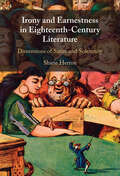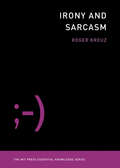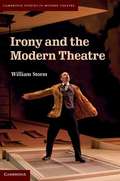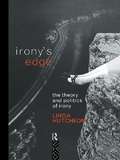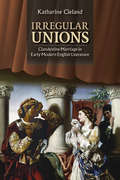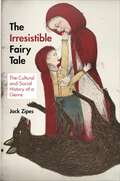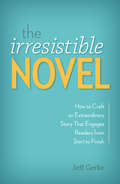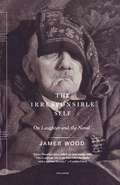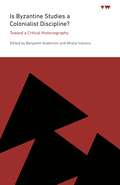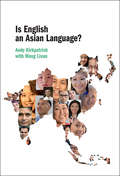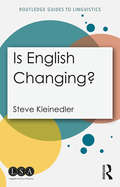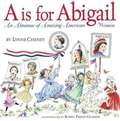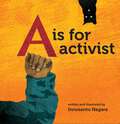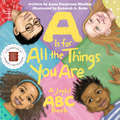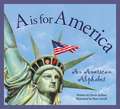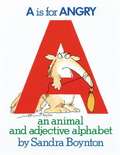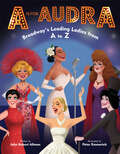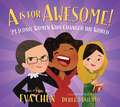- Table View
- List View
Irony and Earnestness in Eighteenth-Century Literature: Dimensions of Satire and Solemnity
by Shane HerronThe conventional literary history of the eighteenth century holds that upstart novelists and other intensely serious writers worked against the conservative and ironic sensibility of an earlier generation of satirists. However, many of these ostensibly earnest writers were exceptional satirists in their own right, employing the same ruses, tricks, and deceptions throughout their work. The novels of such canonical figures as Behn and Defoe, for example, passed themselves off as real documents, just as an earlier generation of hack writers combined the serious and the absurd. Re-examining this nexus between the ludicrous and the solemn, Shane Herron argues that intense earnestness was itself a central component of the ironic sensibility of the great age of literary satire and of Swift's work in particular. The sensationalism and confessionalism of earnestness were frequently employed tendentiously, while ironic and satirical literature often incorporated genuine moments of earnestness to advance writerly aims.
Irony and Sarcasm (The MIT Press Essential Knowledge Series)
by Roger KreuzA biography of two troublesome words. Isn't it ironic? Or is it? Never mind, I'm just being sarcastic (or am I?). Irony and sarcasm are two of the most misused, misapplied, and misunderstood words in our conversational lexicon. In this volume in the MIT Press Essential Knowledge series, psycholinguist Roger Kreuz offers an enlightening and concise overview of the life and times of these two terms, mapping their evolution from Greek philosophy and Roman rhetoric to modern literary criticism to emojis. Kreuz describes eight different ways that irony has been used through the centuries, proceeding from Socratic to dramatic to cosmic irony. He explains that verbal irony—irony as it is traditionally understood—refers to statements that mean something different (frequently the opposite) of what is literally intended, and defines sarcasm as a type of verbal irony. Kreuz outlines the prerequisites for irony and sarcasm (one of which is a shared frame of reference); clarifies what irony is not (coincidence, paradox, satire) and what it can be (among other things, a socially acceptable way to express hostility); recounts ways that people can signal their ironic intentions; and considers the difficulties of online irony. Finally, he wonders if, because irony refers to so many different phenomena, people may gradually stop using the word, with sarcasm taking over its verbal duties.
Irony and the Ironic (The Critical Idiom Reissued #12)
by D. C. MueckeFirst published in 1970 and revised in 1982, this work provides a critical overview of the concept of irony in literary criticism. After establishing the relationship of the ironical and the non-ironical, it summarises the history of the concept of irony, before isolating and discussing its basic aspects and the variable features that determine its nature, effect and quality. The book will be a useful resource for those studying irony and English Literature.
Irony and the Modern Theatre
by William StormIrony and theatre share intimate kinships, not only regarding dramatic conflict, dialectic or wittiness, but also scenic structure and the verbal or situational ironies that typically mark theatrical speech and action. Yet irony today, in aesthetic, literary and philosophical contexts especially, is often regarded with skepticism - as ungraspable, or elusive to the point of confounding. Countering this tendency, Storm advocates a wide-angle view of this master trope, exploring the ironic in major works by playwrights including Chekhov, Pirandello and Brecht, and in notable relation to well-known representative characters in drama from Ibsen's Halvard Solness to Stoppard's Septimus Hodge and Wasserstein's Heidi Holland. To the degree that irony is existential, its presence in the theatre relates directly to the circumstances and the expressiveness of the characters on stage. This study investigates how these key figures enact, embody, represent and personify the ironic in myriad situations in the modern and contemporary theatre.
Irony's Edge: The Theory and Politics of Irony
by Linda HutcheonThe edge of irony, says Linda Hutcheon, is always a social and political edge. Irony depends upon interpretation; it happens in the tricky, unpredictable space between expression and understanding. Irony's Edge is a fascinating, compulsively readable study of the myriad forms and the effects of irony. It sets out, for the first time, a sustained, clear analysis of the theory and the political contexts of irony, using a wide range of references from contemporary culture. Examples extend from Madonna to Wagner, from a clever quip in conversation to a contentious exhibition in a museum. Irony's Edge outlines and then challenges all the major existing theories of irony, providing the most comprehensive and critically challengin theory of irony to date.
Irregular Negatives, Implicatures, and Idioms
by Wayne A. DavisThe author integrates, expands, and deepens his previous publications about irregular (or "metalinguistic") negations. A total of ten distinct negatives--several previously unclassified--are analyzed. The logically irregular negations deny different implicatures of their root. All are partially non-compositional but completely conventional. The author argues that two of the irregular negative meanings are implicatures. The others are semantically rather than pragmatically ambiguous. Since their ambiguity is neither lexical nor structural, direct irregular negatives satisfy the standard definition of idioms as syntactically complex expressions whose meaning is non-compositional. Unlike stereotypical idioms, idiomatic negatives lack fixed syntactic forms and are highly compositional. The final chapter analyzes other "free form" idioms, including irregular interrogatives and comparatives, self-restricted verb phrases, numerical verb phrases, and transparent propositional attitude and speech act reports.
Irregular Unions: Clandestine Marriage in Early Modern English Literature
by Katharine ClelandKatharine Cleland's Irregular Unions provides the first sustained literary history of clandestine marriage in early modern England and reveals its controversial nature in the wake of the Elizabethan Religious Settlement, which standardized the marriage ritual for the first time. Cleland examines many examples of clandestine marriage across genres. Discussing such classic works as The Faerie Queene, Othello, and The Merchant of Venice, she argues that early modern authors used clandestine marriage to explore the intersection between the self and the marriage ritual in post-Reformation England.The ways in which authors grappled with the political and social complexities of clandestine marriage, Cleland finds, suggest that these narratives were far more than interesting plot devices or scandalous stories ripped from the headlines. Instead, after the Reformation, fictions of clandestine marriage allowed early modern authors to explore topics of identity formation in new and different ways.Thanks to generous funding from Virginia Tech and its participation in TOME (Toward an Open Monograph Ecosystem), the ebook editions of this book are available as Open Access volumes from Cornell Open (cornellopen.org) and other repositories.
The Irresistible Fairy Tale: The Cultural and Social History of a Genre
by Jack ZipesA provocative new theory about fairy tales from one of the world's leading authoritiesIf there is one genre that has captured the imagination of people in all walks of life throughout the world, it is the fairy tale. Yet we still have great difficulty understanding how it originated, evolved, and spread—or why so many people cannot resist its appeal, no matter how it changes or what form it takes. In this book, renowned fairy-tale expert Jack Zipes presents a provocative new theory about why fairy tales were created and retold—and why they became such an indelible and infinitely adaptable part of cultures around the world.Drawing on cognitive science, evolutionary theory, anthropology, psychology, literary theory, and other fields, Zipes presents a nuanced argument about how fairy tales originated in ancient oral cultures, how they evolved through the rise of literary culture and print, and how, in our own time, they continue to change through their adaptation in an ever-growing variety of media. In making his case, Zipes considers a wide range of fascinating examples, including fairy tales told, collected, and written by women in the nineteenth century; Catherine Breillat's film adaptation of Perrault's "Bluebeard"; and contemporary fairy-tale drawings, paintings, sculptures, and photographs that critique canonical print versions.While we may never be able to fully explain fairy tales, The Irresistible Fairy Tale provides a powerful theory of how and why they evolved—and why we still use them to make meaning of our lives.
The Irresistible Novel: How to Craft an Extraordinary Story That Engages Readers from Start to Finish
by Jeff GerkeDiscover Your Voice and Enthrall Readers! The craft of writing is filled with various debates: Should I include a prologue? Should I delete all adverbs from my manuscript? Just how much backstory--if any--can I include in my story? These questions--and their often-contradictory answers--can cause confusion, frustration, and even paralysis in the writer. The Irresistible Novel frees you from the limits of so-called "rules" and instead provides you with a singular goal: You must engage your readers from beginning to end. Filled with down-to-earth discussions on the various debates of writing, as well as innovative research on neuroscience and reader response, this book shows you how to: Navigate the various debates on writing fiction--showing versus telling, purple prose, outlining, writing description, and more--to decide what kind of novelist you want to be. Hack your reader's brain to hook her interest and trigger emotional engagement from the very first page. Incorporate enduring elements of storytelling from masters like Joseph Campbell, Aristotle, and Carl Jung. Readers want to be swept away by your stories. When you eschew the rules and focus on your readers' desires, you're free to write truly irresistible fiction.
The Irresponsible Self: On Laughter and the Novel
by James Wood"James Wood has been called our best young critic. This is not true. He is our best critic; he thinks with a sublime ferocity." - Cynthia Ozick. Following the collection The Broken Estate-- which established James Wood as the leading critic of his generation-- The Irresponsible Self confirms Wood's preeminence, not only as a discerning judge but also as an appreciator of contemporary novels.
Is Byzantine Studies a Colonialist Discipline?: Toward a Critical Historiography (ICMA Books | Viewpoints)
by Benjamin Anderson and Mirela IvanovaIs Byzantine Studies a colonialist discipline? Rather than provide a definitive answer to this question, this book defines the parameters of the debate and proposes ways of thinking about what it would mean to engage seriously with the field’s political and intellectual genealogies, hierarchies, and forms of exclusion.In this volume, scholars of art, history, and literature address the entanglements, past and present, among the academic discipline of Byzantine Studies and the practice and legacies of European colonialism. Starting with the premise that Byzantium and the field of Byzantine studies are simultaneously colonial and colonized, the chapters address topics ranging from the material basis of philological scholarship and its uses in modern politics to the colonial plunder of art and its consequences for curatorial practice in the present. The book concludes with a bibliography that serves as a foundation for a coherent and systematic critical historiography. Bringing together insights from scholars working in different disciplines, regions, and institutions, Is Byzantine Studies a Colonialist Discipline? urges practitioners to reckon with the discipline’s colonialist, imperialist, and white supremacist history.In addition to the editors, the contributors to this volume include Andrea Myers Achi, Nathanael Aschenbrenner, Bahattin Bayram, Averil Cameron, Stephanie R. Caruso, Şebnem Dönbekci, Hugh G. Jeffery, Anthony Kaldellis, Matthew Kinloch, Nicholas S. M. Matheou, Maria Mavroudi, Zeynep Olgun, Arietta Papaconstantinou, Jake Ransohoff, Alexandra Vukovich, Elizabeth Dospěl Williams, and Arielle Winnik.
Is English an Asian Language?
by Andy Kirkpatrick Wang LixunAsia is now home to some 800 million multilingual speakers of English, more than the total number of native English speakers, and how they use English is continuously evolving and changing to reflect their cultural backgrounds and everyday experiences. Can English, therefore, be considered an Asian language? Drawing upon the Asian Corpus of English, this book will be the first comprehensive account of the roles, uses and features of English in Asia, encompassing several different varieties of Asian English. Chapters cover the distinctive linguistic features of English in different settings, such as in law, religion and popular culture, as well as the use of local rhetorical, pragmatic and cultural styles and its use as a lingua franca among Asian multilinguals. It will also examine the role of English in education - from primary through to higher education - and consider the implications of this for other languages of Asia.
Is English Changing? (Routledge Guides to Linguistics)
by Steve KleinedlerIs English changing? To what degree is it changing? Is this change good or bad? In answering these questions, Is English Changing? provides a lively and concise introduction to language change, refuting commonly held misconceptions about language evolution as we understand it. Showing that English, like all living languages, has historically changed and continues to change, this book: analyzes developments in the lexicon, the way words are spoken or written, and the way in which speakers and writers use words; offers a basic overview of the major subfields of linguistics, including phonetics, morphology, syntax, semantics, pragmatics, and sociolinguistics, all viewed through the prism of language change; discusses change over time with examples from Old English, Middle English, and Modern English; reinforces important concepts with examples from other languages, including Spanish, Japanese, and Czech; clearly defines key terms and includes advice on rules, usage, and style, as well as ample annotated further reading and activities throughout. Aimed at undergraduate students with little or no prior knowledge of linguistics, this book is essential reading for those studying this topic for the first time.
A Is For Abigail: An Almanac Of Amazing American Women
by Lynne Cheney Robin Preiss GlasserLynne Cheney and Robin Preiss Glasser collaborated on America: A Patriotic Primer, which captured the imagination of American children and became a national best-seller. Now they turn their hands to A is for Abigail: An Almanac of Amazing American Women and bring the great women of American history to life. Filled to the brim with words and pictures that celebrate the remarkable (although often unmarked) achievements of American women, this is a book to relish and to read again and again. <p><p> Mothers, daughters, schoolchildren, generations of families -- everyone -- will take Abigail Adams's words to heart and "remember the ladies" once they read the stories of these astonishing, astounding, amazing American women.
A is for Activist
by Innosanto NagaraOne of NPR's Top 100 Book for Young Readers &“Reading it is almost like reading Howard Zinn's A People's History of the United States, but for two-year olds—full of pictures and rhymes and a little cat to find on every page that will delight the curious toddler and parents alike.&”—Occupy Wall StreetA is for Activist is an ABC board book written and illustrated for the next generation of progressives: families who want their kids to grow up in a space that is unapologetic about activism, environmental justice, civil rights, LGBTQ rights, and everything else that activists believe in and fight for. The alliteration, rhyming, and vibrant illustrations make the book exciting for children, while the issues it brings up resonate with their parents' values of community, equality, and justice. This engaging little book carries huge messages as it inspires hope for the future, and calls children to action while teaching them a love for books.
A Is for Africa
by Ifeoma Onyefulu"This alphabet is based on my own favorite images of the Africa I know. I come from the Igbo tribe and grew up in southeastern Nigeria. It was in Nigeria that these photographs were taken, but the people and things pictured reflect the rich diversity of the continent as a whole. There are examples of Moslem and Arabic influences from the north of my country, as well as costumes and ornaments from the south where the religions are animist or Christian. These religions are found in other African countries, too. There are kola nuts, indigo, and beaded jewelry and the ways in which Nigerians use them. And though other Africans may use a different kind of nut, a different color dye, and jewelry that looks different, the meanings and customs associated with them are the same. I wanted to capture what the people of Africa have in common: traditional village life, warm family ties, and above all, the hospitality for which Africans are famous. This book shows what Africa is to me, but it is for and about all the peoples of this vast, friendly, colorful continent." Other books by Ifeoma Onyefulu are available in this library.
A Is for Alien: An ABC Book (Little Golden Book)
by Charles GouldIn space no one can hear you giggle as you read this Little Golden Book for all ages featuring the characters from the classic movie Alien!Follow Ripley and the rest of the Nostromo crew on a space adventure that introduces the alphabet from A to Z. With fun illustrations, this light-hearted reimagining of the iconic movie Alien will delight fans young and old, as well as Little Golden Book collectors throught the universe.Since 1979, Alien has been an iconic franchise that has thrilled viewers around the world.Little Golden Books enjoy nearly 100% consumer recognition. They feature beloved classics, hot licenses, and new original stories . . . the classics of tomorrow.
A Is for All the Things You Are: A Joyful ABC Book
by Anna Forgerson Hindley Nat'l Mus Afr Am Hist CultureAn ABC book celebrating and inspiring diversityA Is for All the Things You Are: A Joyful ABC Book is an alphabet board book developed by the National Museum of African American History and Culture that celebrates what makes us unique as individuals and connects us as humans. This lively and colorful book introduces young readers, from infants to age seven, to twenty-six key traits they can explore and cultivate as they grow. Each letter offers a description of the trait, a question inviting the reader to examine how he or she experiences it in daily life, and lively illustrations. The book supports understanding and development of each child's healthy racial identity, the joy of human diversity and inclusion, a sense of justice, and children's capacity to act for their own and others' fair treatment.
A Is for Aloha: A Hawai'i Alphabet
by U'Ilani GoldsberryThe landscape of Hawai'i is as rich and exotic as its history and residents. A Is for Aloha: A Hawai'i Alphabet offers readers of all ages a guided A-Z tour through this fascinating state. From the meaning of the word "aloha" to the plight of the state bird, the néné, to the sparkling beaches on the island of O'ahu, author U'ilani Goldsberry welcomes all "malihinis" (newcomers) to this lush multi-island paradise. Spectacular paintings from artist Tammy Yee bring the text to vivid life. Beginning readers will enjoy the simple rhymes while older children discover facts about each topic letter in the sidebar expository. Aloha is our letter A. It means so many things: hello, good-bye, and love to you. Fair wishes this word brings. Travelers young and old will enjoy this fact-filled guide to one of the most-visited places on earth! The book includes a quiz about Hawai'i and a pronunciation key of Hawaiian words and their meanings. Check the Bookshare collection for several more alphabet books about other states including B is for Buckeye.
A Is for America: An American Alphabet
by Devin ScillianFrom the British and our Constitution that replaced their rule, to Yellowstone and Zane Grey's stories of the west, A is for America is a sweeping tribute to all we know and love about our country. Other alphabet books filled with fun facts include: B is for Buckeye: An Ohio Alphabet, L is for Lincoln: An Illinois Alphabet, L is for Lobster: A Maine Alphabet, M is for Maple: A Canadian Alphabet, M is for Mitten: A Michigan Alphabet, S is for Sunshine: A Florida Alphabet, and V is for Volunteer: A Tennessee Alphabet. More states coming soon! It is indeed important, how America came to be. It's the idea that an individual can insist on being free. And I is for immigration and the immigrants who came from Italy, Ireland or India, we're Americans all the same. With delightful poems that beg to be read aloud, and expository text to broaden reader's reader's horizons, this American alphabet will make you fall in love with the United States over and over again. The letter X should remind us of the importance of election day, when all Americans rich and poor are allowed to have their say. Some were told they couldn't vote if they couldn't write their name. So they signed the ballot with a letter X and it counted just the same. Bright, beautifully detailed illustrations from California artist Pam Carroll bring each letter to vibrant life, from eagles and Thomas Edison to the veterans of two world wars. Celebrate all that is Americana with A is for America: An American Alphabet.
A Is for America: An American Alphabet
by Devin ScillianThe author of the charming fable "Fibblestax" includes a rhyming poem for each letter of the alphabet and informational text about the United States.
A Is for Angry
by Sandra Boynton"Because you can't stand another apple, ball, or cup," Sandra Boynton presents an alphabet book of animals and adjectives. An Angry Animal Assortment Along an Arrow starts off the whimsy as a Big Bashful Bear, a Cute Clean Cat, a Tangled Turkey, a Wide Walrus, a Yellow Yak, and others in between romp through the letters A-Z. In classic Boyton style, the irresistible animal characters climb the tall letters, perch on the squat ones, hang from the curves of the round ones. Selection of the Book-of-the-Month Club. Suitable for ages 3-5.
A Is for Arches: A Utah Alphabet
by Becky HallWhat do the Mormon Tabernacle Choir, the Sego lily, and the Utah raptor have in common? They are among the many treasures offered by the state of Utah and featured in A is for Arches: A Utah Alphabet. Readers of all ages will enjoy this guided A-Z tour that showcases state symbols and history in an entertaining and educational format. Beginning readers will enjoy the simple rhymes, while older children discover facts about each topic letter in the sidebar expository. We'll start with Utah's Arches, made from wind, frost, and rain. Nature's rocky sculptures-- An art that can't remain. Author Becky Hall's descriptive rhymes and informative text are highlighted by artist Katherine Larson's vivid, original artwork. From H is for Handcarts to Z is for Zion National Park, A is for Arches presents the history, landscape, and people of the great state of Utah.
A Is for Audra: Broadway's Leading Ladies from A to Z
by John Robert Allman"It's an incredible honor to be included in this amazing book of the greatest talent the Broadway stage has ever known!"—AUDRA McDONALD, six-time Tony Award-winning actressFrom Audra McDonald to Liza with a "Z," here is a showstopping alphabet book featuring your favorite leading ladies of the Broadway stage!Step into the spotlight and celebrate a cavalcade of Broadway's legendary ladies. Start with "A" for six-time Tony Award winner Audra McDonald, then sing and dance your way through the alphabet with beloved entertainers like Patti LuPone, Bernadette Peters, Chita Rivera, Lea Salonga, Kristin Chenoweth, Kelli O'Hara, and Liza Minnelli! Broadway fans and theater lovers everywhere will give a standing ovation to this one-of-a-kind tribute full of toe-tapping rhymes, with illustrations as bright and beautiful as the shining lights on any marquee.AND DON'T MISS THE SEQUEL COMING IN OCTOBER: B IS FOR BROADWAY: ONSTAGE AND BACKSTAGE FROM A TO Z!THE RAVE REVIEWS ARE IN FROM THE STARS THEMSELVES! A wonderful, enriching, enlightening book for theater lovers of all ages . . . and all that jazz!"—CHITA RIVERA, two-time Tony Award-winning actress (The Rink, Kiss of the Spider Woman)"A to Z—awesome to zany—I'm thrilled to be a part of such an illustrious group."—CHRISTINE EBERSOLE, two-time Tony Award-winning actress (42nd Street, Grey Gardens)"I'm so honored to be included among these fierce ladies—brought to life with such fun illustrations—in this wonderful book for little divas like my own!"—LEA SALONGA, Tony Award-winning actress (Miss Saigon)"A is for Audra turns the alphabet song into a show stopper! It is literally a love letter to Broadway's leading ladies, and I am so honored to be memorialized alongside all of my sisters!"—RENÉE ELISE GOLDSBERRY, Tony Award-winning actress (Hamilton)"I'm honored to be included in this illustrious group. A to Z, they are all incredible!"—KRISTIN CHENOWETH, Tony Award-winning actress (You're a Good Man, Charlie Brown)"What a fun and fabulous celebration of the females of Broadway! Imagine my joy just to be a part of it!"—KELLI O&’HARA, Tony Award-winning actress (The King and I)&“H is also for honored—because that&’s what I am to be included in this beautiful book. I can&’t wait to show my kids and tell them of all the brilliant leading ladies who have graced the Broadway stage.&” —HEATHER HEADLEY, Tony Award–winning actress (Aida)AND CRITICS LOVE IT TOO! "Women of the Broadway theater take center stage in this loving homage. . . . A lively introduction to a whole new cast of heroines."—Kirkus"this is a book all kids (and many adults) will enjoy as they learn about and fall in love with the theatre."—Playbill.com"A true necessity for any kid&’s bookshelf."—Entertainment Weekly&“a thorough, eye-catching introduction to women of the theater. . . . budding theater lovers will get a thrill.&”—Booklist"A sure hit for thespians of all ages."—School Library Journal"Emmerich&’s flattering caricatures, paired with [Allman&’s] verse, are colorful and slick, bringing Broadway&’s drama to the page&”—Publishers Weekly
A Is for Awesome!: 23 Iconic Women Who Changed the World
by Eva ChenWhy stick with plain old A, B, C when you can have Amelia (Earhart), Malala, Tina (Turner), Ruth (Bader Ginsburg), all the way to eXtraordinary You—and the Zillion of adventures you will go on?Instagram superstar Eva Chen, author of Juno Valentine and the Magical Shoes, is back with an alphabet board book depicting feminist icons in A Is for Awesome: 23 Iconic Women Who Changed the World, featuring spirited illustrations by Derek Desierto.
